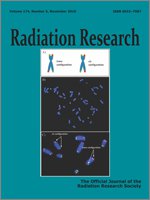It is well established that high-LET radiations efficiently induce chromosome aberrations. However, data on the effect of protons on telomere maintenance, as involved in genomic stability, are scarce and contradictory. Here we demonstrate that high-LET protons induce telomere lengthening in human primary fibroblasts and that this elongation does not involve the telomerase enzyme, supporting the hypothesis that high-LET radiations are able to activate a telomerase-independent mechanism. In tumor cells that lack telomerase, one or more non-telomerase mechanisms for telomere maintenance are present, which are termed alternative lengthening of telomeres (ALT). Since ALT cells are characterized by recombinational events at telomeres, known as telomeric-sister chromatid exchanges (T-SCE), and colocalization of telomeres and premyelocytic leukemia protein (PML), we analyzed both T-SCE and PML. Our results show that high-LET protons induce a 2.5-fold increase of T-SCE and a colocalization of PML protein and telomeric DNA. Furthermore, our data show that the ALT pathway can be activated in human primary cells after induction of severe DNA damage. Thus, since telomeres are known to be involved in chromosome maintenance, the present work may contribute in the elucidation of the mechanism by which ionizing radiation induces genomic instability.
How to translate text using browser tools
30 July 2010
Transient Activation of the ALT Pathway in Human Primary Fibroblasts Exposed to High-LET Radiation
F. Berardinelli,
A. Antoccia,
R. Cherubini,
V. De Nadal,
S. Gerardi,
G. A. P. Cirrone,
C. Tanzarella,
A. Sgura
ACCESS THE FULL ARTICLE

Radiation Research
Vol. 174 • No. 5
November 2010
Vol. 174 • No. 5
November 2010




